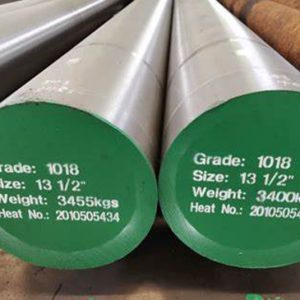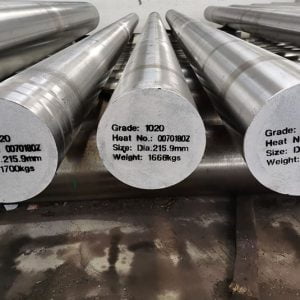Introduction
Choosing the right material is crucial for the success of any project. Whether you’re working in manufacturing, construction, or any other industry, the properties of the material you choose can significantly impact the performance and longevity of your final product. 1045 steel, a medium-carbon steel, is renowned for its versatility and favorable mechanical properties. This blog will provide an in-depth look at why 1045 steel is ideal for a wide range of applications.
What is 1045 Steel?

Composition and Properties
1045 steel is a medium-carbon steel with the following chemical composition:
| Element | Percentage (%) |
|---|---|
| Carbon | 0.42-0.50 |
| Manganese | 0.60-0.90 |
| Phosphorus | ≤ 0.040 |
| Sulfur | ≤ 0.050 |
Mechanical Properties
1045 steel exhibits a good balance of mechanical properties, making it suitable for various applications. Here are some key properties:
| Property | Value |
|---|---|
| Tensile Strength | 570 – 700 MPa |
| Yield Strength | 300 MPa |
| Elongation | 16% |
| Hardness (HB) | 170-210 |
| Modulus of Elasticity | 205 GPa |
Heat Treatment
1045 steel can be heat treated to enhance its mechanical properties. Common heat treatment processes include annealing, normalizing, quenching, and tempering. Heat treatment can improve hardness, tensile strength, and impact resistance.
Advantages of 1045 Steel
Strength and Durability
1045 steel is known for its strength and durability, making it an ideal choice for components that require resistance to wear and impact. Its tensile strength and hardness are higher than those of lower carbon steels, which contributes to its robustness.
Machinability
Machinability is a crucial factor in the selection of materials, especially for manufacturing processes that involve machining. 1045 steel offers excellent machinability, allowing for precise and efficient shaping, cutting, and drilling. This property reduces manufacturing costs and time.
Versatility
One of the standout features of 1045 steel is its versatility. It is used in various applications, including shafts, gears, bolts, and machine parts. Its adaptability to different manufacturing processes and requirements makes it a preferred choice across industries.
Cost-Effectiveness
Despite its superior properties, 1045 steel is relatively cost-effective compared to other high-carbon steels. Its availability and ease of processing contribute to lower production costs, making it an economical choice for many projects.
Heat Treatment Flexibility
1045 steel responds well to heat treatment, allowing engineers to tailor its mechanical properties to specific requirements. This flexibility makes it suitable for applications that demand varying levels of hardness and strength.
Common Applications of 1045 Steel
Automotive Industry
1045 steel is extensively used in the automotive industry for manufacturing components such as axles, crankshafts, and gears. Its strength and wear resistance make it ideal for parts that endure significant stress and strain.
Construction
In the construction sector, 1045 steel is utilized in the production of structural elements and machinery components. Its ability to withstand heavy loads and its durability make it a reliable choice for construction projects.
Machinery and Equipment
Machinery and equipment manufacturers often use 1045 steel for creating machine parts, including shafts, pins, and rods. Its machinability and mechanical properties ensure that these parts perform reliably under demanding conditions.
Tooling
1045 steel is also used in the tooling industry for making dies, molds, and other tools that require high strength and wear resistance. The material’s ability to undergo heat treatment allows for the production of durable and long-lasting tools.
Comparing 1045 Steel with Other Steels
To better understand why 1045 steel is an excellent choice, let’s compare it with some other commonly used steels.
1045 Steel vs. 1018 Steel
| Property | 1045 Steel | 1018 Steel |
|---|---|---|
| Carbon Content | 0.42-0.50% | 0.15-0.20% |
| Tensile Strength | 570 – 700 MPa | 440 – 470 MPa |
| Yield Strength | 300 MPa | 370 MPa |
| Hardness (HB) | 170-210 | 126 |
| Machinability | Good | Excellent |
| Cost | Moderate | Low |
1045 steel offers higher strength and hardness compared to 1018 steel, making it suitable for applications requiring greater durability. However, 1018 steel has better machinability and is more cost-effective for less demanding applications.
1045 Steel vs. 4140 Steel
| Property | 1045 Steel | 4140 Steel |
|---|---|---|
| Carbon Content | 0.42-0.50% | 0.38-0.43% |
| Chromium Content | 0% | 0.80-1.10% |
| Tensile Strength | 570 – 700 MPa | 655 – 865 MPa |
| Yield Strength | 300 MPa | 415 MPa |
| Hardness (HB) | 170-210 | 197-237 |
| Machinability | Good | Moderate |
| Cost | Moderate | Higher |
4140 steel, an alloy steel, offers higher tensile and yield strength than 1045 steel, along with better toughness and fatigue resistance. However, it is more expensive and has slightly lower machinability.
Heat Treatment of 1045 Steel
Heat treatment processes are used to enhance the mechanical properties of 1045 steel. Below are the common heat treatment methods applied to 1045 steel:
Annealing
Annealing involves heating the steel to a specific temperature and then slowly cooling it. This process improves ductility and reduces hardness, making the steel easier to machine.
Normalizing
Normalizing involves heating the steel to a temperature above its critical range and then air cooling. This process refines the grain structure, enhancing toughness and strength.
Quenching and Tempering
Quenching involves heating the steel to a high temperature and then rapidly cooling it in water or oil. This process increases hardness but can make the steel brittle. Tempering is done after quenching to reduce brittleness while retaining hardness and strength. The steel is reheated to a lower temperature and then air cooled.
Induction Hardening
Induction hardening is a surface hardening technique that uses electromagnetic induction to heat the steel’s surface rapidly, followed by quenching. This method increases surface hardness and wear resistance while maintaining a tough core.
Typical Heat Treatment Temperatures for 1045 Steel
| Process | Temperature Range (°C) | Cooling Method |
|---|---|---|
| Annealing | 800 – 850 | Furnace |
| Normalizing | 870 – 920 | Air |
| Quenching | 820 – 870 | Water/Oil |
| Tempering | 400 – 650 | Air |
| Induction Hardening | 780 – 820 | Water/Oil |
Working with 1045 Steel
Machining 1045 Steel
1045 steel’s machinability is rated as good, which makes it a popular choice for manufacturing processes that require precision and efficiency. Here are some tips for machining 1045 steel:
- Use Sharp Tools: Ensure that cutting tools are sharp to minimize tool wear and achieve clean cuts.
- Optimal Cutting Speed: Maintain an optimal cutting speed to balance tool life and machining time.
- Coolant Use: Apply coolant to reduce heat buildup and prevent workpiece deformation.
- Feed Rate: Adjust the feed rate to achieve the desired surface finish and avoid excessive tool wear.
Welding 1045 Steel
Welding 1045 steel can be challenging due to its higher carbon content, which can lead to cracking. Preheating the steel before welding and controlling the cooling rate can help prevent weld-related issues. Post-weld heat treatment may also be necessary to relieve stresses and improve the weld’s mechanical properties.
Forming and Forging
1045 steel is suitable for forming and forging processes. Preheating the steel to the appropriate temperature range can facilitate deformation and reduce the risk of cracking. Controlled cooling after forming or forging is essential to achieve the desired mechanical properties.
Case Studies and Real-World Applications

Automotive Industry
In the automotive industry, 1045 steel is used for manufacturing high-strength components such as axles and crankshafts. For example, a leading automobile manufacturer chose 1045 steel for their crankshaft production due to its excellent balance of strength, machinability, and cost-effectiveness. The crankshafts produced from 1045 steel exhibited superior performance under high-stress conditions, leading to improved vehicle reliability and customer satisfaction.
Construction Projects
A construction company used 1045 steel for producing structural components of a high-rise building. The steel’s strength and durability ensured that the structural elements could
withstand heavy loads and resist wear over time. Additionally, the cost-effectiveness of 1045 steel helped the company stay within budget while maintaining high safety standards.
Industrial Machinery
An industrial machinery manufacturer selected 1045 steel for making machine parts, including shafts and gears. The steel’s machinability allowed for precise manufacturing of complex parts, while its strength and toughness ensured that the machine components could endure harsh operating conditions and provide long-lasting performance.
Conclusion
1045 steel is an ideal material for various projects due to its balanced combination of strength, hardness, machinability, and cost-effectiveness. Whether you are working in the automotive, construction, or manufacturing industries, 1045 steel offers the versatility and reliability needed to ensure the success of your projects.
By understanding the properties, advantages, and applications of 1045 steel, you can make informed decisions that maximize the value and performance of your final product. Regular maintenance and proper heat treatment are essential to maintaining the steel’s optimal properties and ensuring long-term durability.
FAQ
What is the main advantage of using 1045 steel?
The main advantage of using 1045 steel is its balanced combination of strength, hardness, and machinability, making it suitable for a wide range of applications and cost-effective compared to other high-carbon steels.
How can 1045 steel be heat treated to improve its properties?
1045 steel can be heat treated through processes such as annealing, normalizing, quenching, tempering, and induction hardening. These processes enhance the steel’s mechanical properties, such as hardness, strength, and toughness.
Is 1045 steel suitable for welding?
Welding 1045 steel can be challenging due to its higher carbon content, which can lead to cracking. Preheating the steel before welding and controlling the cooling rate can help prevent weld-related issues. Post-weld heat treatment may also be necessary.
What are some common applications of 1045 steel?
Common applications of 1045 steel include automotive components (axles, crankshafts), construction structural elements, machine parts (shafts, gears), and tooling (dies, molds).
How does 1045 steel compare to 1018 and 4140 steel?
1045 steel offers higher strength and hardness compared to 1018 steel but has slightly lower machinability. Compared to 4140 steel, 1045 steel has lower tensile and yield strength but is more cost-effective and easier to machine. The choice between these steels depends on the specific requirements of the application.





